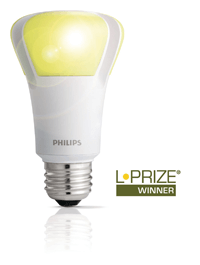LED Lights Have a Bright Future
February 28, 2012 — by Per Christensson
 Last year, Philips won the "L Prize," a light bulb performance award given out by the U.S. Deparment of Energy (DoE). The award criteria is based on 1) energy efficiency, 2) performance, 3) reliability, and 4) customer acceptance. Philips' LED bulb beat out all competitors to win the $10 million dollar cash prize. While that may seem like a lot of money (and it is), the label of "L Prize winner" will probably generate far more revenue for Philips in the next few years.
Last year, Philips won the "L Prize," a light bulb performance award given out by the U.S. Deparment of Energy (DoE). The award criteria is based on 1) energy efficiency, 2) performance, 3) reliability, and 4) customer acceptance. Philips' LED bulb beat out all competitors to win the $10 million dollar cash prize. While that may seem like a lot of money (and it is), the label of "L Prize winner" will probably generate far more revenue for Philips in the next few years.
LED lights are great. The provide consistent, bright lighting and can be tuned to a number of different colors and hues. They are way more efficient than traditional incandescent bulbs and don't contain mercury like compact fluorescents (CFLs). Best of all, they can be used with a fader, allowing you to have complete control over their brightness.
There has been a lot of talk in recent years hyping up CFLs. There were even some bills proposed in the U.S. congress that would require people to switch from incandescent to CFL bulbs. Fortunately, this didn't happen. Instead, the bill that was passed required all light bulbs (primarily incandescents) to meet new energy efficiency standards.
There are lots of problems with CFLs. First of all, they contain mercury, which means these "environmentally friendly" bulbs are actually harmful to the environment. You can't just throw out CFLs, you are required to drop them off at a light bulb recycling facility. Secondly, CFLs give off that annoyingly bright white light, which is anything but comfortable. Thirdly, and worst of all, you can't fade standard CFLs. You can buy super expensive CFLs that work on a fader, but from my experience, they don't work too well. As you fade the lights down, they flicker, just like overhead fluorescent bulbs connected to an old ballast. Since I fade nearly all the lights in my house, this is a big deal to me. Thank goodness I haven't been forced to CFLs.
This whole discussion about CFLs is rather pointless anyway, since LEDs are the lights of the future. They use a fraction of the energy that incandescent bulbs use, last way longer (often up to 25,000 hours), and they are solid state, which means they are extremely durable. The reliability of LED lights makes them appropriate for just about any lighting purpose. In fact, you may have noticed that many cars now use LEDs for daytime running lights. Kudos to Audi for pioneering this design and now being the first company to include LED headlights on their cars. Those are some sweet looking lights.
The biggest disadvantage of LEDs is that they cost a lot. The high quality ones currently cost around $30 - $50 per bulb. However, the prices should drop substantially as LED bulbs become more widely available. While the transition won't happen immediately, I am guessing that in about ten years, nearly all light bulbs will be LEDs.
 Home
Home February 20th
February 20th